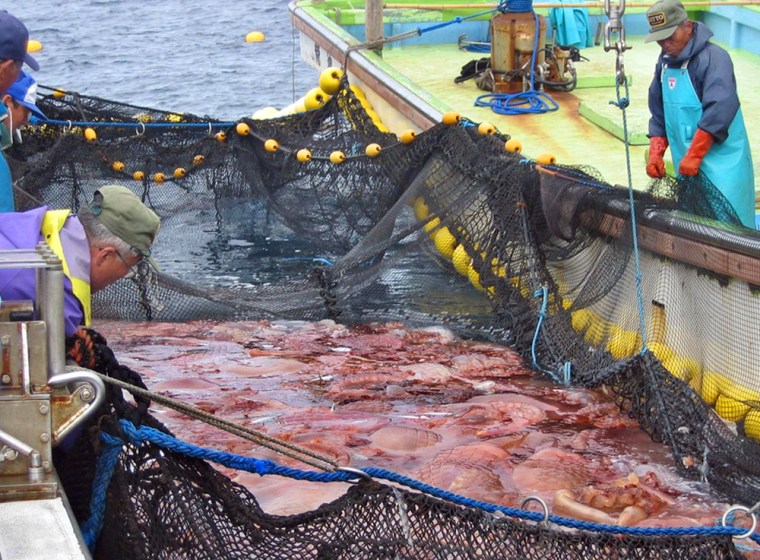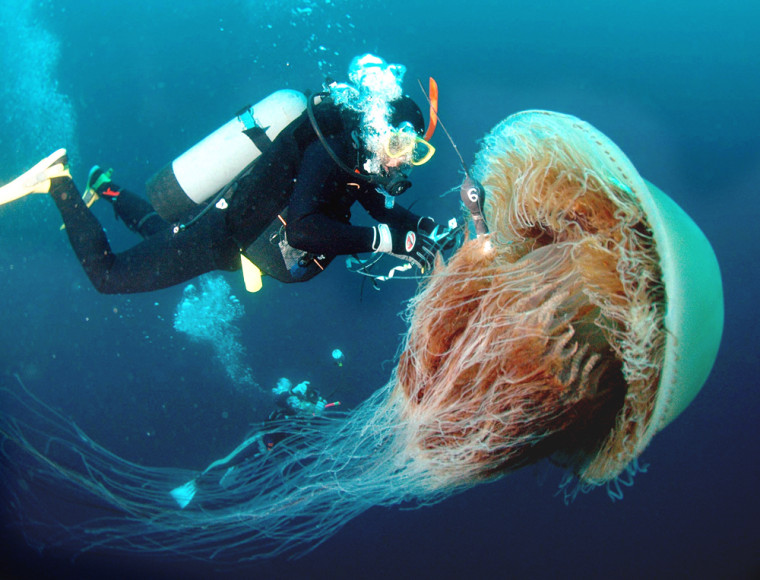A slimy jellyfish weighing as much as a sumo wrestler has Japan's fishing industry in the grip of its poisonous tentacles.
Vast numbers of Echizen kurage, or Nomura's jellyfish, have appeared around Japan's coast since July, clogging and ripping fishing nets and forcing fishermen to spend hours hacking them apart before bringing home their reduced catches.
Representatives of fishing communities around the country gathered in Tokyo last week, hoping to thrash out solutions to a pest that has spread from the Japan Sea to the Pacific coast.
"It's a terrible problem. They're like aliens," Noriyuki Kani of the fisheries federation in Toyama, northwest of Tokyo, told Reuters.
There are no official figures on the size of the problem, but Kani says the financial losses are obvious. "If your nets are full of jellyfish, of course there is no space for fish," he said.
Cutting up and disposing of the giants can turn a three-hour fishing trip into a 10-hour marathon, while valuable fish are poisoned or crushed under the weight of the unwanted catch.
6-foot-long invertebrates
And what a catch: One Echizen kurage can be more than 6 feet (2 meters) in diameter and weigh up to 440 pounds (200 kilograms).
Despite their size, the invertebrates aren't toxic enough to cause serious harm to humans, but fishermen often wear goggles and protective clothing to avoid stings when dealing with them.

Much about the jellyfish, the largest variety found in the Sea of Japan, remains a mystery, according to Hitoshi Iizumi of the Seikai National Fisheries Research Institute in Niigata.
Researchers have suggested they drift to Japan on currents after reproducing in South Korean or Chinese waters, a theory that Japan wants to investigate with the other two nations. But with relations between Japan and its nearest neighbors at a low ebb, Tokyo is anxious to avoid apportioning blame.
"We have a neutral stance," said Yukihiko Sakamoto of the National Fisheries Agency, which organized last Thursday's conference. "It doesn't matter whether the jellyfish come from South Korean waters or Japanese waters. We just want to do something to minimise the damage to the fishing industry," he said.
Is global warming to blame?
One-off spikes in population have occurred in the past, notably in 1958, but consecutive outbreaks in 2002 and 2003 prompted the government to seek reasons and solutions. Scientists have suggested global warming might be a factor.
Some fishermen have had some success in combating the intruders by introducing guide nets with larger-than-usual holes. Jellyfish are simply swept through the holes by water currents, while other fish tend to notice the nets and swim alongside them, eventually being trapped in the fishing nets.
"By altering the way we fish, we have probably secured 80 to 90 percent of our normal catch," said fisherman Masatoshi Kuruma, who said he has in the past found up to 2,000 or 3,000 jellyfish in his nets off Nyuzenmachi in Toyama prefecture.
Officials at the conference considered a forecasting system that would allow fishermen to prepare for the next onslaught of the jumbo jellyfish.
Jellyfish ice cream?
South Korean fishermen have been suffering similar woes, but China, where giant jellyfish are a delicacy often served dried and dressed with sesame oil, does not seem to have registered the outbreak as a major problem, Japanese officials said.
Seaside communities in Japan have tried to capitalize on the menace by developing novel jellyfish dishes, ranging from tofu to ice cream, but for some reason the recipes have failed to take off.
Participants at the conference said they had experimented with feeding the jellyfish to farmed crabs and using them as fertilizer.
